11 best landing page builders in 2024 for every use case
 Cesar, customer support
Cesar, customer support
The best landing page builder for you depends on your specific needs. Just as a carpenter selects a saw based on what they want to build, the tool you choose should help you create pages that push you toward your goals.
To help you make a decision, we've compiled this list of the 11 best landing page builders for 2024. Each option has its own unique features and pricing plan, so keep reading to discover more about each tool and find the best one for you. 👇
We spent hours researching each product and gathering the experiences of users to understand what each one excels at. As this is a “best of” list, all the tools have far more pros than cons, but we aim to highlight the specific reasons and use cases where one could be better than another. We don’t receive payments to place tools in our articles or earn money from affiliate links.
Want to skip ahead? Jump to the comparison table. ⬇️
What to look for when choosing a landing page builder
When choosing a landing page builder, define what you want to use your pages for and then consider the features, price, usability, and support that you need.
Typical reasons you might want to use a landing page include:
Collect email newsletter signups
Promote a lead magnet
Sell digital products and courses
Create a basic home page for a new idea
Convert people who click on paid ads
Once you've specified your reason, choose a tool with the features that fit.
For example, if you plan to promote a lead magnet, choose a tool with email marketing features to deliver it. Or, if you plan to sell digital products or courses, choose a tool with payments and checkout features.
Does it have the features you need?
Some of these tools are dedicated landing page builders without any other features. Others allow you to create websites, run email marketing, or even sell courses and memberships.
We can’t list all the features on offer. Some of the most important ones to look out for include:
Visual builder
Forms and pop-ups
A/B testing
Surveys and quizzes
E-commerce and product sales
Email marketing features or integrations
Ad pixel setup
Templates
Website building
Read this article for a rundown of the best landing pages to see the types of features to look out for.
Is the price within your budget?
Landing page software pricing varies significantly—the tools on our list range from $9 to $299 per month.
It isn’t the case that more features equals higher costs. Many of the most expensive tools only allow you to create landing pages but justify this with features that help marketers who are already spending big on paid ads.
Some tools also allow you to create and publish landing pages for free. Typically this is on a domain that features the product’s name. However, that’s not the case for all apps. Ycode allows you to publish to a custom domain for free and Elementor has a fairly full-featured free version for WordPress users.
Check out a pricing overview in the table below.
 MailerLite
MailerLite
|
|
 Carrd
Carrd
|
|
 Swipe Pages
Swipe Pages
|
 Instapage
Instapage
|
 Elementor
Elementor
|
 Ecomposer
Ecomposer
|
 Landingi
Landingi
|
|
|
|
|---|---|---|---|---|---|---|---|---|---|---|---|
| Free plan | |||||||||||
| Starting price per month | $10 | $12 | $9 | $49 | $39 | $299 | $59 per year | $19 | $49 | $99 | $147 |
Is it easy to use for someone with your skill set?
All the tools on our list use visual no-code builders that make it possible to create responsive landing pages without knowing how to code. However, the tools that offer more control over design and features can be harder to get to grips with than simpler tools with fewer customization options.
Does it include email marketing features or integrate with relevant tools?
Your landing page is only the first part of your funnel. To effectively generate sales, you need a post-sign-up email funnel that nurtures leads into customers. Some tools on our list, such as MailerLite and ClickFunnels, have these features built into the platform.
Others have integrations that allow you to connect to a third-party email marketing tool. If you choose one of the latter platforms, just remember to consider the price of an email service provider when calculating the total cost.
Also, look for the ability to connect to paid ads, analytics, CRM, or e-commerce and payments tools.
What type of customer support does it offer?
Even easy-to-use tools require some getting used to. Customer support helps you get set up and create effective landing pages. Look for knowledge bases and lesson libraries to help you solve problems independently and live support to help you when you get stuck.
Landing page builder features comparison
Here’s an easy-to-read comparison of the features offered by each of the tools on our list. The exact features you can access will depend on the plan you choose.
 MailerLite
MailerLite
|
|
 Carrd
Carrd
|
|
 Swipe Pages
Swipe Pages
|
 Instapage
Instapage
|
 Elementor
Elementor
|
 Ecomposer.io
Ecomposer.io
|
 Landingi
Landingi
|
|
|
|
|---|---|---|---|---|---|---|---|---|---|---|---|
| Visual builder | |||||||||||
| Surveys/quizzes | |||||||||||
| A/B testing | Smart traffic | ||||||||||
| Forms | |||||||||||
| Pop ups | |||||||||||
| Integrations | 130+ | MailerLite, Zapier, Airtable | ESP, payments, analytics | 20+ | 7+ | 120+ | 39+ | 35+ | 30+ | 34+ | 5+ |
| Email marketing | Autoresponder | ||||||||||
| Support | 24/7 chat, email | Email and live chat | Phone, chat, email | 12/5 chat, email | 24/5 chat, emails | 24/7 chat | 24/7 chat | Phone 10/5, email | 19/5 chat and phone, email | 24 hour chat Mon to Fri, 9 AM to 5 PM ET chat weekends |
11 best landing page builders
Now you know what to look for, here is our list of the 11 best landing page tools. Read on to discover a summary of each one, its features, and its pros and cons.
MailerLite - Best landing pages with marketing automation

MailerLite is a user-friendly platform that combines landing pages with powerful email marketing functionality. The large template library, drag & drop builder with pre-made blocks, and global design settings mean you can create and publish pages in minutes. Meanwhile, forms, pop-ups, countdown timers, surveys and e-commerce features help you convert visitors into customers or leads.
MailerLite is a front-runner because of its post-conversion features. You can create custom thank you pages that encourage leads to take the next step in the funnel, such as watching a webinar or buying a related product. And you can use MailerLite’s powerful email marketing toolkit to deliver lead magnets and set up targeted email automation based on almost any trigger.
Features
Publish new pages in minutes thanks to a drag & drop landing page builder and tons of templates
Easily collect leads with customizable forms and pop-ups
Drive engagement with advanced blocks like quizzes, surveys, and animations
Increase sales with countdown timers, coupons, and testimonials
Immediately take the next step in the funnel with custom thank-you pages
Add the Facebook pixel to your site in seconds with custom code, or use the integration to create custom Facebook audiences from your email list
Promote and sell products from your landing page with Stripe and e-commerce integration
A/B test different versions of your landing page to see which converts best
Create automated funnels that convert with MailerLite’s powerful email features
Go beyond landing pages by building multi-page websites with an SEO-optimized blog
Access built-in analytics or add Google Analytics code in seconds
See where people click on your page with heatmaps
Pros
Very easy to use: The visual drag & drop builder is super user-friendly, while prebuilt blocks and templates speed up the time it takes to go live. Published landing pages look sleek and modern
Plenty of conversion-focused features: Forms, payments, coupons, timers, surveys, quizzes and email marketing features mean MailerLite is a powerful platform for turning website visitors into customers
Extremely cost-effective: Create 10 landing pages for free or publish unlimited pages to a custom domain for just $10 per month. This plan also includes email marketing features for up to 1,000 contacts
24/7 real-time support: All paid plans can access 24/7 support to help you succeed. Anyone can access the customer community, knowledge base, learning courses, and help documentation
Cons
Best suited to MailerLite users: MailerLite’s built-in email marketing features mean it’s the best option for people who use MailerLite as opposed to another ESP. However, it’s easy to migrate to MailerLite from other email platforms, such as Mailchimp.
Free to create and publish up to 10 landing pages on a MailerLite domain
$9 per month to create and publish unlimited landing pages on custom domains
$19 per month to also access the Facebook integration, promotional pop-ups and multi-trigger automation
Publish your first landing page with MailerLite
Sign up to design and publish your first landing page on MailerLite today. Access all templates, blocks, and email marketing features with a 30-day free trial of our advanced plan. No credit card required!
Ycode - Complete design flexibility
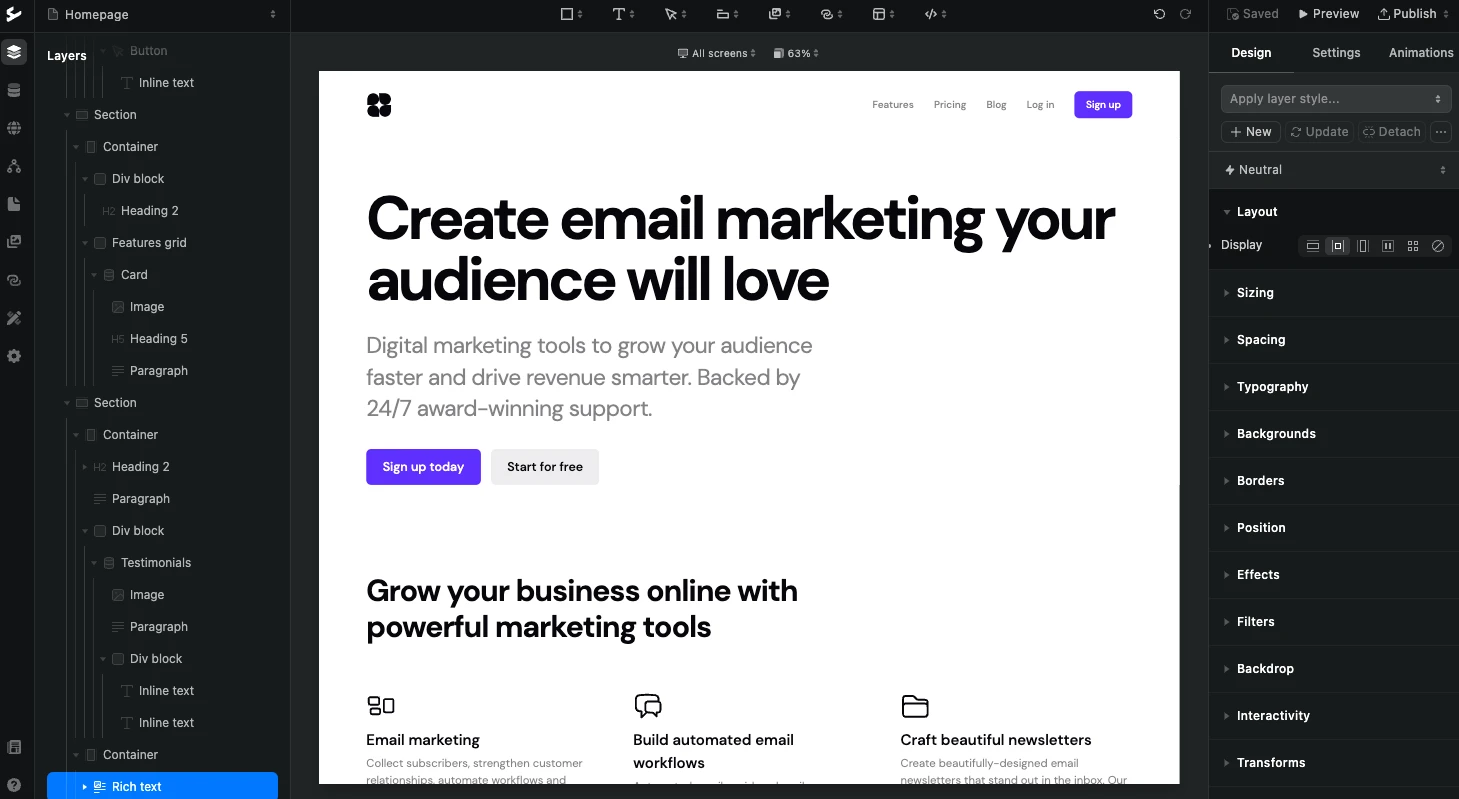
Ycode is an advanced web app, website and landing page tool that allows granular control over all aspects of your site design. Additionally, database features mean you can create landing pages and websites with advanced functionality like job boards and marketplaces.
The downside to this flexibility is that the Ycode learning curve is steeper than the other options on this list. Non-designers may find it hard to create pages that look professional—although, the template library and prebuilt layouts will help.
The tool also has some conversion-focused features, such as forms that you can easily connect to MailerLite to create post-conversion automation. Ycode is also the only builder we could find that lets you publish your page to a custom domain for free.
Features
Visual editor
Reusable components
Template library and prebuilt layouts
CMS tools
Customizable forms
Databases for dynamic content
Pros
Create almost any design: Ycode’s advanced design features allow you to create almost any website or landing page design
Affordable: Publish a website on a custom domain for free. Paid plans start at just $12 per month
Advanced features: Create connections between CMS items, such as assigning an author to a blog post, or build searchable and filterable lists
Cons
Steep learning curve: Advanced features mean it can take time to learn the tool
Publish a website or landing page on a custom domain for free
$12 per month to create a 100-page website
$24 per month for 200 pages
3. Carrd - For simple one-page websites
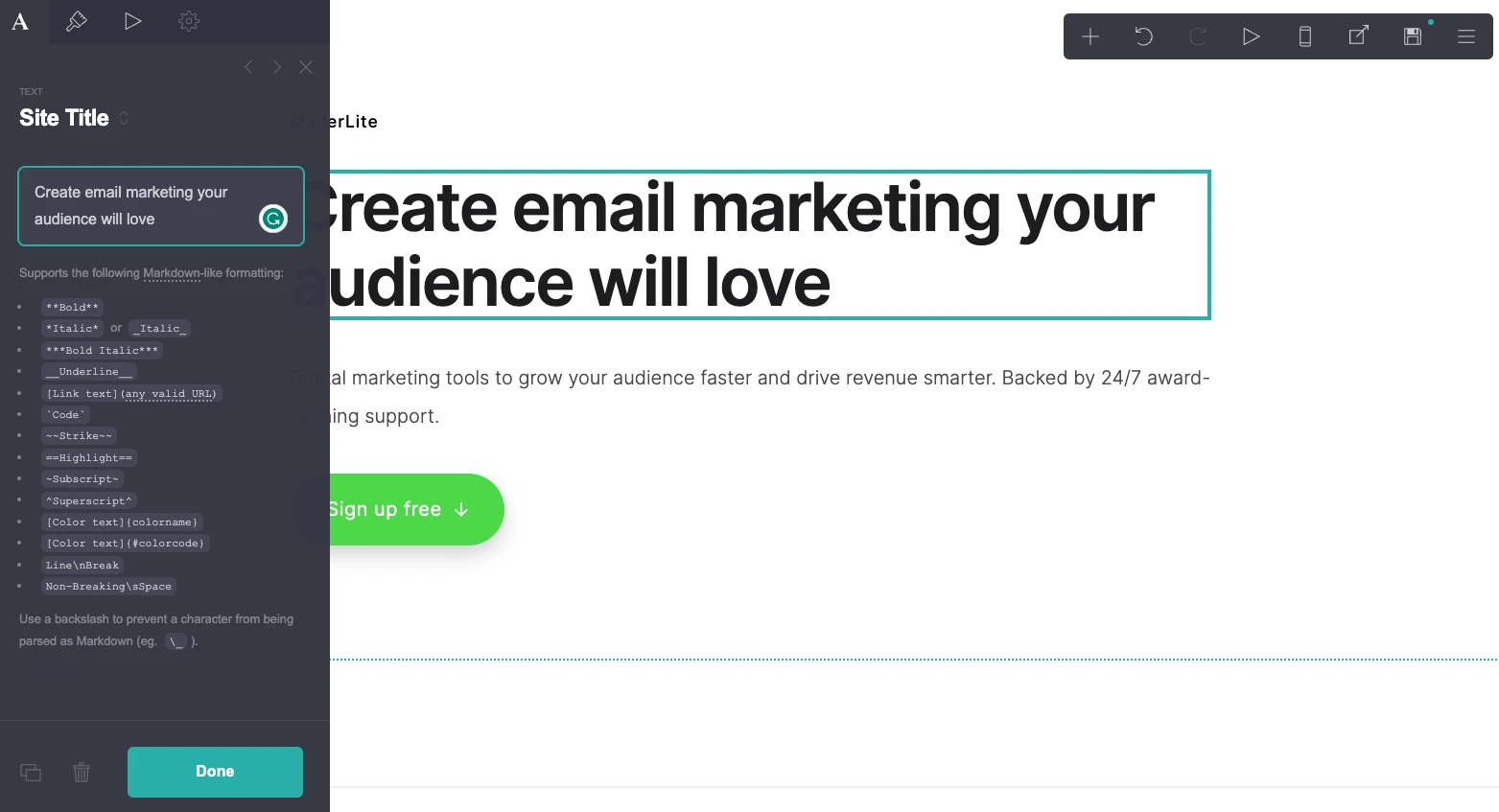
Carrd makes creating one-page websites and landing pages easy. Getting started is as simple as choosing a blank canvas or template and then editing it using the drag-and-drop builder.
The tool has containers, columns, and all the basic blocks you need to create great-looking websites. We especially liked the animations feature, which helps your pages stand out when compared to static sites.
Carrd has some conversion-focused features such as lead generation forms that integrate with email marketing platforms like MailerLite. You can also add widgets for payment platforms like Stripe.
The biggest downside is that Carrd lacks some advanced blocks like surveys, quizzes, thank you pages or the ability to integrate with e-commerce platforms. You also can’t create anything beyond single-page websites.
Features
Visual drag-and-drop editor
Forms that connect to your email service provider
Templates for various use cases
Stripe widgets for sales
Animations on scroll
Pros
Super easy to use: Creating a great-looking website is easy with Carrd. Start with a template or build a site from scratch
Pages look sleek and modern: You have plenty of customization opinions to make designs you’re happy with
Extremely affordable: Publish sites to a Carrd domain for free or get full access for just $9 per month or $19 per year
Cons
One-page websites only: You can’t build multi-page websites, which means you’re limited if you ever want to go beyond a landing page
Lacks advanced blocks: Carrd doesn’t have advanced blocks like quizzes, surveys, pop-ups, or a native Facebook Pixel installation
Free to build pages and publish them to a Carrd domain
$9 per month or $19 per year for the pro plan
4. Leadpages - Conversion guidance and full websites

Leadpages is a landing page builder focusing on conversions. The standout feature is the conversion guidance tool which suggests improvements based on best practices like the color choices of call-to-actions (CTAs). You also get forms, pop-ups, payments and countdown timers.
You can also go beyond single pages and build an entire website. This is useful if you don’t have a website and want to keep your landing pages and homepage on the same platform.
The downside is the price; at $49 per month, it’s more expensive than some other tools on this list, although by no means the most expensive. You also need the $99 per month plan to access online selling and A/B testing features, which are standard in some other tools.
Features
Drag-and-drop page builder
Large template library
Conversion guidance
AI text generation included
Integrations with other tools
A/B testing
Built-in checkout
Website and pop-up builder
Pros
Conversion-focused: Leadpages is built for marketers who want to create landing pages to convert. The conversion guidance feature makes suggestions to improve your pages
Goes beyond landing pages: You can create popups, forms, and even full websites
Real-time support: Phone (Pro and Advanced plans) and chat support (all paid plans) are available from 9 AM until 5 PM central time
Cons
Price: Leadpages starts at $49 per month while advanced features like A/B testing and online sales require a $99 per month Pro plan
14-day free trial
$49 per month for Standard plan
$99 per month for Pro plan with A/B testing
5. Swipe Pages - Best for AMP pages
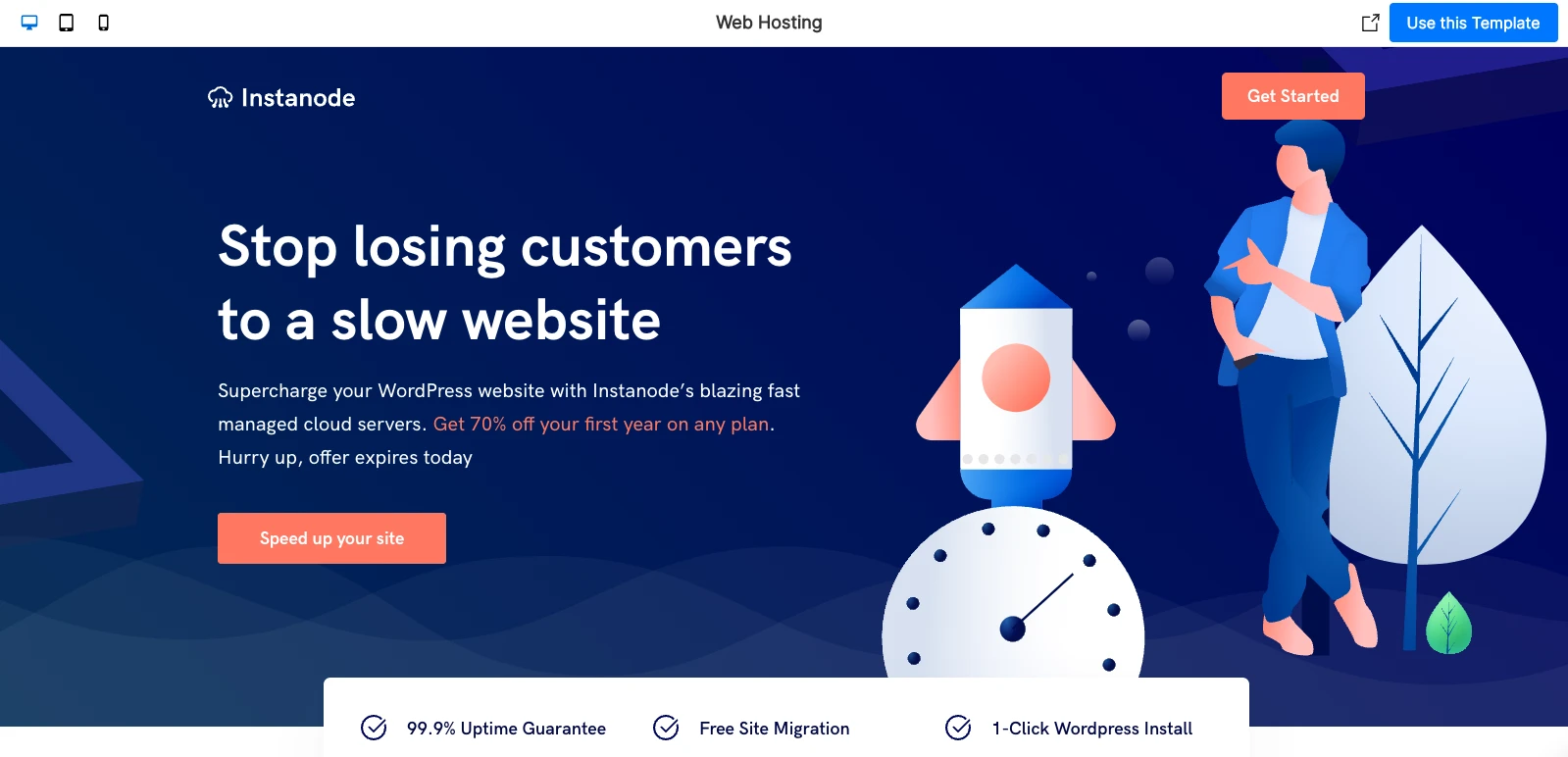
Swipe Pages is a conversion-focused landing page builder that stands out because it helps you build AMP pages that are served from Google’s cache and load instantly when people click on a mobile ad. It’s a super useful feature if you plan to use paid ads as slow-loading websites can negatively impact conversion.
The tool has plenty of useful conversion features. Dynamic content lets you display different text on a landing page depending on the specific ad the person clicked through to reach it. And multi-step forms encourage people to complete long forms by breaking them down into smaller steps.
The downside is the price and the fact that some essential features are only available on more advanced plans. The tool focuses entirely on landing pages, so you don’t get extras like websites, email marketing or pop-ups.
Features
Drag-and-drop landing page builder with templates
Stripe integration
Dynamic text
A/B testing
Analytics tools
Multi-step forms
Pros
Features for paid ads: Features like fast-loading AMP pages, multi-step forms, dynamic text and A/B testing are built to help you convert visitors from paid ads
Get started fast: Templates, a visual builder, image and icon library, and copyable blocks make building landing pages easy
Cons
Limited use cases: Swipe Files is great if you want to create pages for Google ads, but it lacks features that other more versatile tools have, like websites and email marketing
Expensive: Many of the best features require an $89 per month Marketer plan which is expensive compared to some other options
Free 14-day trial
$39 per month for the Startup plan
$89 per month for the Marketer plan with A/B testing and other advanced features
6. Instapage - Build funnels for paid ads
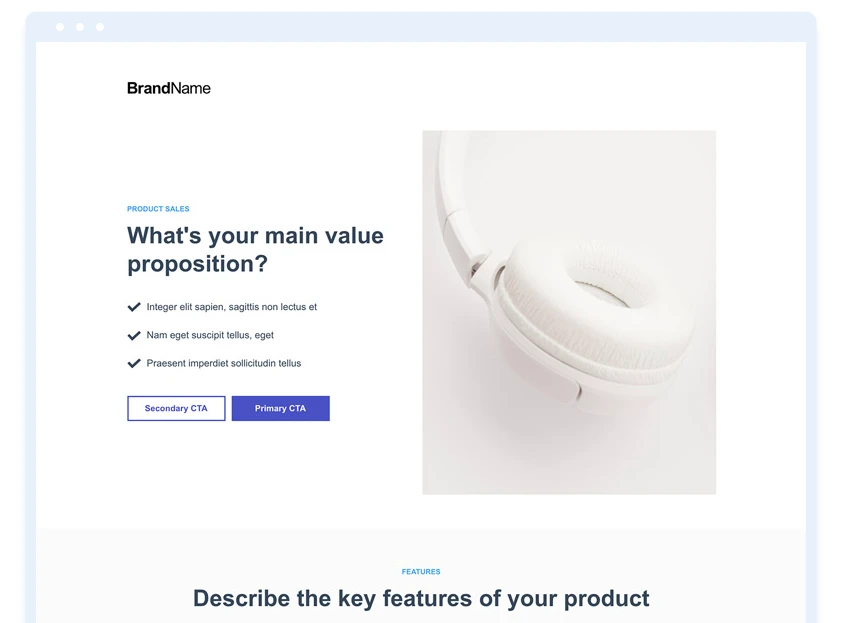
Instapage is a landing page builder built for paid ads campaigns. Standout features include personalization which lets you target content to specific audience segments, and AdMap, which makes it easy to visualize the customer journey and connect landing pages to relevant ads.
Building custom pages is simple and fast, which helps when creating multiple pages for large campaigns. We also like that the templates include suggestions on what to include in each section. This means you don’t have to think about what to include when writing your pages.
The major downside is the price: the cheapest plan costs $299 per month, limits you to 30 published landing pages, and doesn’t give you access to all the available features. Instapage also lacks any additional marketing features.
Features
Visual landing page builder
AI content generator
120+ integrations
Personalized content
A/B testing and analytics
Customer journey map
Team collaboration
Templates
Pros
Easy to use: Anyone can create landing pages that convert thanks to templates, AI content, and a visual builder
Always on support: Access live chat 24 hours a day from Monday to Friday
Cons
Pricing: It’s a costly tool with pricing that will be out of reach for many small businesses and entrepreneurs
14-day free trial
$299 per month for Build plan
7. Elementor - Best for WordPress websites
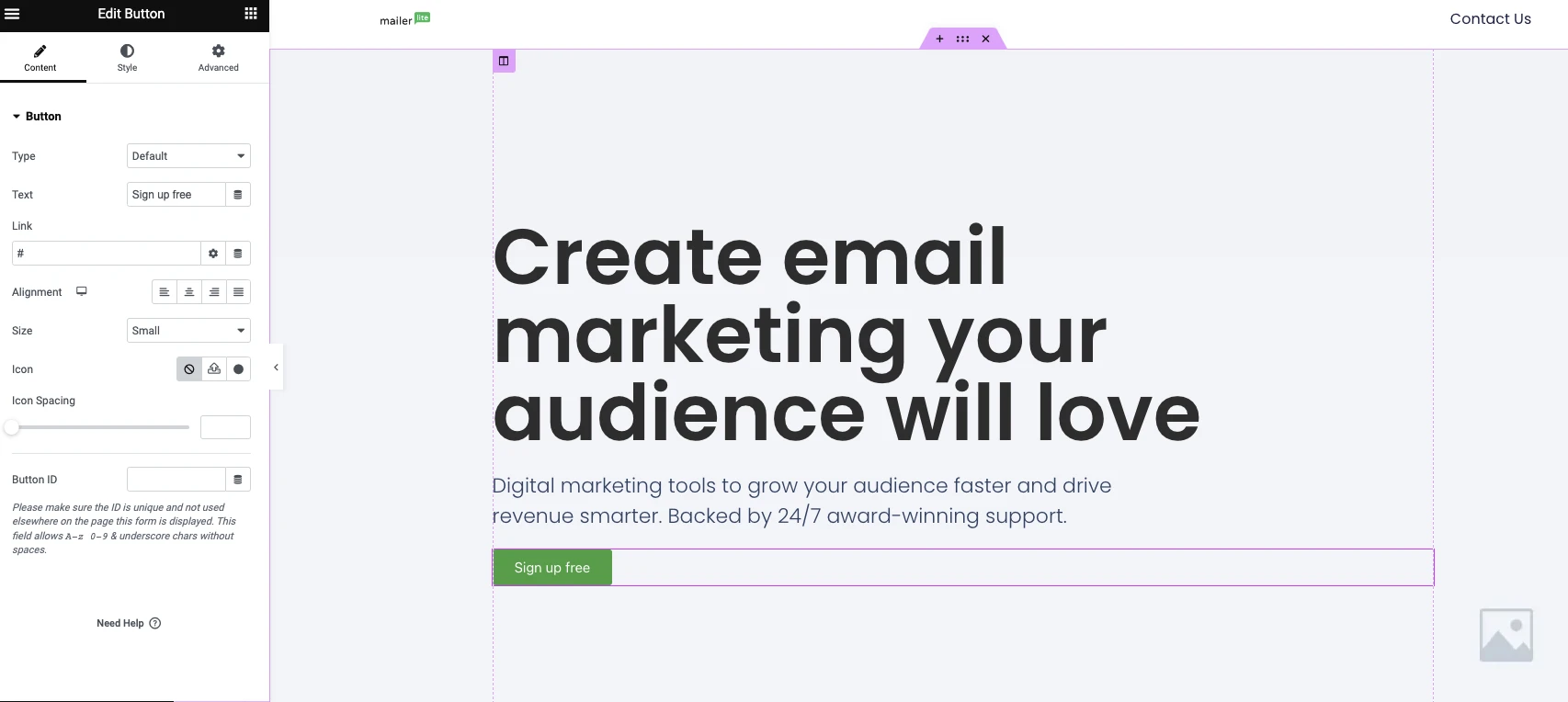
Elementor is a WordPress page and website builder that allows you to create entirely custom designs without code. It’s more flexible than a dedicated landing page builder thanks to granular customization options and over 100 widgets, including posts, forms, countdown timers, and add-to-cart buttons.
The downside is that Elementor lacks some specific conversion-related features like split testing and analytics. It’s also only for WordPress websites, so you won’t be able to use it if your site is on another CMS. Getting set up with WordPress is more complicated than using some of the other options on this list.
Features
Drag-and-drop editor
Over 300 templates
Over 100 widgets
Blog functionality
Forms
Global styling
Countdowns and testimonials
Stripe and PayPal buttons
Pros
Flexible designs: Enables you to design almost any website in WordPress. Start with a template chosen from over 100 full website designs
Affordable: Publish free landing pages with the basic WordPress plugin, while the paid version costs just $59 per year for full access. You need your own hosting plan to use the plugin
WordPress hosting: You can buy hosting through Elementor to simplify site management
Cons
Only for WordPress: If your website isn’t on WordPress, you can’t use Elementor
Steep learning curve: The advanced web design features mean the tool has a steeper learning curve than some of the other options on this list
Free page builder with many customizable features
$59 per year for a single site and full feature access, including the form and pop-up builder via the WordPress plugin
$9.99 per month for one site on the hosted solution
8. Ecomposer.io - Landing pages for Shopify websites

Ecomposer is a website and landing page builder for Shopify stores. It has all you need to create beautiful websites and landing pages on the platform, including over 100 templates and a visual page builder suitable for beginners. The tool works with all Shopify themes, making it easy to build custom sites on the platform.
The free version of the tool lets you publish 3 templates, including landing pages. And it comes with conversion-focused features such as upsells, add-to-cart buttons, back-in-stock announcements, and cross-selling tools. The downside is that it only works with Shopify websites.
Features
Drag-and-drop landing page and website builder
Over 200 pre-made templates
19 built-in extensions and apps including cross-selling, product options, and sales notifications
Testimonials and countdown timers
Forms
Add to cart blocks
Pros
Lots of extras: Comes with 19 extensions that expand the functionality of the tool and reduce the need for more 3rd party tools
Support: Ecomposer offers 24/7 live chat support on all paid plans
Start for free: The free plan lets you create and publish a landing page for free
Cons
Missing some conversion features: Lacks some conversion features like A/B testing, pop-ups, and email marketing
Only works with Shopify stores: You can’t use the tool if your website uses a different platform
Free version for 3 pages with limited features
$19 per month for 15 templates and more features
9. Landingi - Built-in CRM and funnels
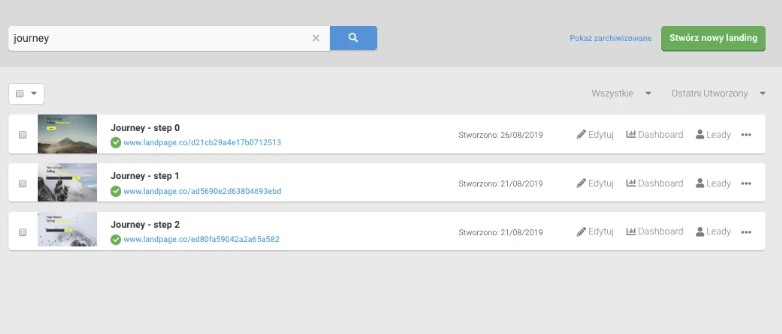
Landingi stands out due to the built-in CRM and the ability to group landing pages into funnels. You can also create custom thank you pages to continue pushing visitors toward a sale.
It’s possible to set up an autoresponder to deliver lead magnets or push users to the next funnel stage. But you’ll need to connect to a third-party email marketing platform to create full nurture sequences.
Features
Drag-and-drop editor and templates
Pop-ups and forms
Internal CRM with ESP integrations
Analytics and A/B split testing
Dynamic content
Funnel grouping and thank you pages
Simple email features
Pros
CRM: The CRM lets you store contacts in the Landingi platform, set up autoresponders and integrate with your email platform
Funnels: Group landing pages into funnels to create clear customer journeys
Large template library: The tool has an extensive template library which makes getting started easy
Cons
Limited email features: You can set up an autoresponder but will need a third-party tool for more advanced email marketing campaigns
Free to launch a single landing page with Landingi branding
$49 per month for unlimited landing pages and all features
10. Unbounce - Best for smart creation features
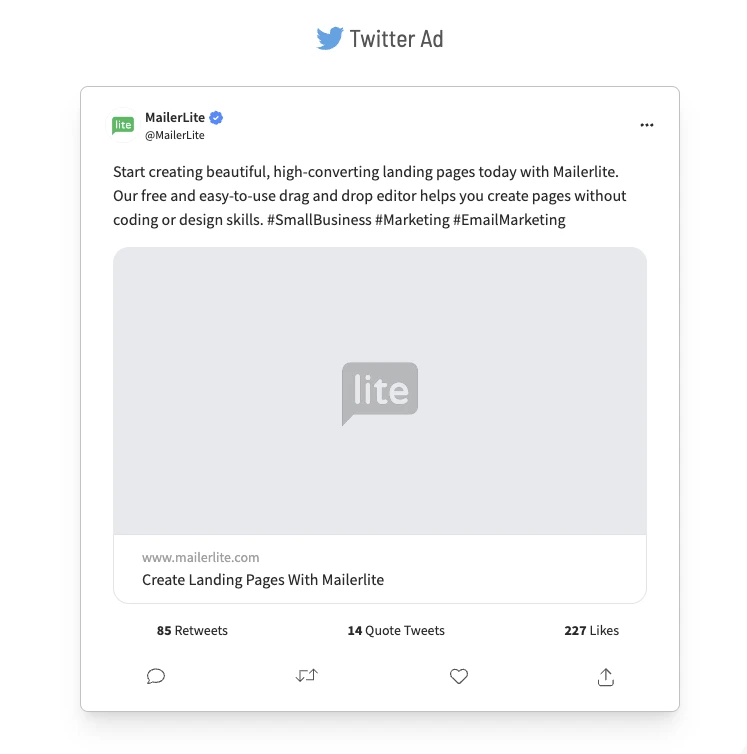
Unbounce has an easy-to-use visual page builder to help you create landing pages and forms. But what makes it unique are the smart creation tools, which include a page builder that automatically suggests landing page layouts and generates on-brand copy; and a traffic optimization tool that analyzes visitor attributes and sends people to relevant web pages based on particular criteria.
The downside is that Unbounce lacks the extra features provided by some of the other tools on this list, such as websites or email. It also uses a conversion-based pricing model that can see your costs rise quickly.
Features
Landing page builder
AI content creation
AI optimization suggestions
Analytics and A/B testing
Forms, sticky bars and pop-ups
Dynamic text replacement
Landing page templates
Pros
Smart builder: This tool suggests landing page designs and copy to make it fast to create and publish landing pages
Traffic optimization: This feature claims to analyze visitor attributes and send them to the page most likely converting them into a lead or customer
Cons
Conversion-based pricing: Paying based on the number of conversions means costs can soon add up. Whether it’s worth it will depend on the value of a conversion to your brand
AI copy not always perfect: The content suggestions are typically quite good, but you should keep a close eye on the output to ensure it’s suitable for your brand
14-day free trial
$99 per month for up to 500 conversions and 20,000 visitors
$145 per month for 1,000 conversions and up to 30,000 visitors
$240 per month for 2,500 conversions and up to 50,000 visitors
11. ClickFunnels - Best for creating complex funnels
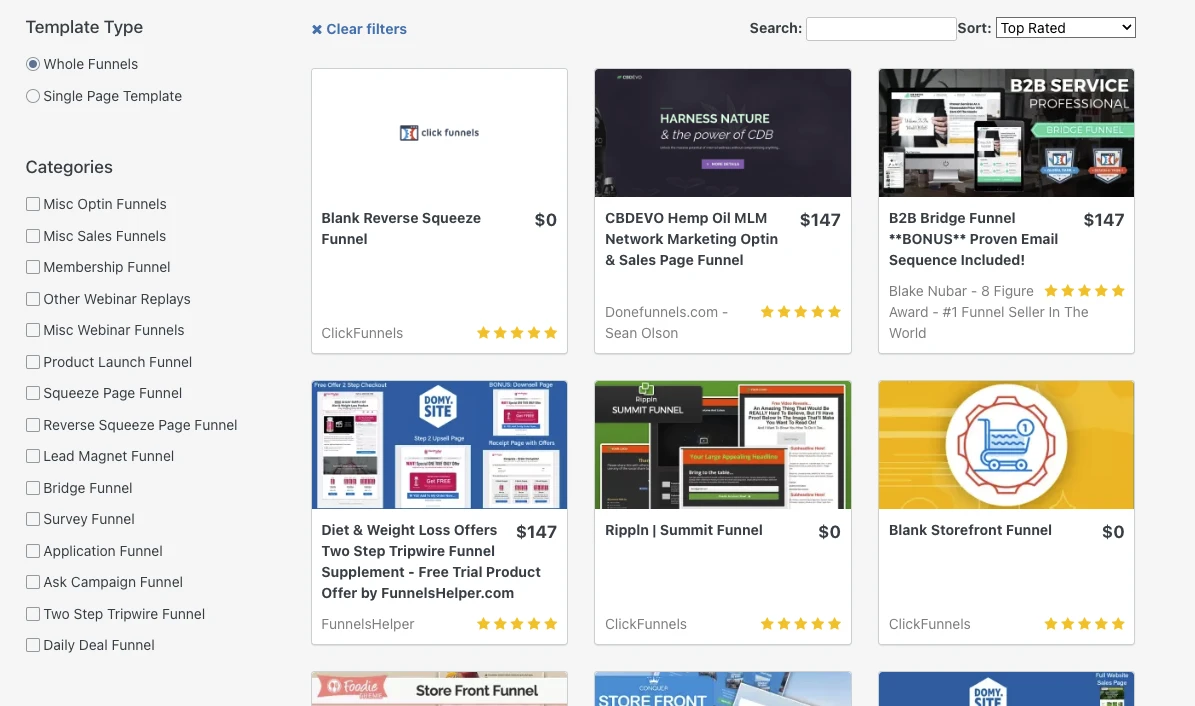
ClickFunnels helps you create entire sales funnels to sell your products. Funnels are combinations of landing pages and email marketing flows that aim to convert visitors into customers.
The tool goes beyond a typical landing page creator by including features like online courses, memberships, email marketing and affiliate programs. It has a template marketplace to help you start, although you need to pay extra to use some of them.
The tool is easy to use once you get to grips with the idea of funnels. The issue is that it’s expensive—unless you plan to use all the features, there are cheaper options.
Features
Websites
Landing pages
Shopping carts
CRM
Analytics
Courses and memberships
E-commerce
Blog
A/B testing
Pros
Feature-rich: ClickFunnels includes a huge array of features that can power almost any kind of online business. It’s an all-in-one tool
Easy to use: The tool makes setting up complex funnels easy, which helps beginners market their products effectively
Cons
Expensive: ClickFunnels is expensive unless you plan to make the most of the extra features
Restrictive: The fact it’s an all-in-one tool means it’s unlikely to be a good choice if you already have a website, store or email marketing platform set up
14-day free trial
$147 per month for 1 website and 20 funnels
$197 per month for 100 funnels
$297 per month for unlimited funnels
Final tips to choosing the best landing page builder
You have tons of options when it comes to choosing a landing page builder. To simplify your decision, think about the exact features you need.
If you need the ability to create a complete funnel, choose a tool like MailerLite or ClickFunnels. Or, if you want complete control over your website design, choose Ycode or Elementor.
Alternatively, if you plan to spend on Google or social media ads and don’t mind paying extra for a landing page platform, consider one of the more conversion-focused tools on our list like Instapage or Unbounce.
Try MailerLite today
Sign up for a free account to publish your first landing page today. Our 30-day free trial lets you access all the marketing features you need to turn page visitors into customers.
